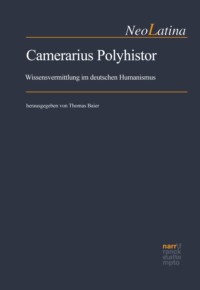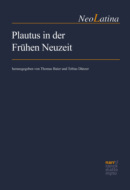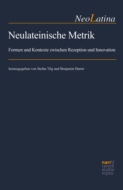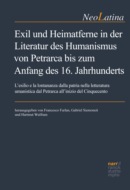Kitabı oku: «Camerarius Polyhistor», sayfa 6
The most extensive, however, are his philological works, obviously intended for use in university tuition, as can be seen not only in the manuals of style, rhetoric and grammar, but also in the forewords to his many commented editions of Greek and Latin texts, from HomerHomer to Christian late antiquity. These editions formed the core of Camerarius’ philological activity and form the qualitative arguments upon which he might be considered the most important Humanist after ErasmusErasmus von Rotterdam, Desiderius. His primary activity was that of a critic, editor, and commentator; he edited and annotated, among others, the following: DemosthenesDemosthenes (1524, 1547), TheocritusTheokrit (1530, 1545), Dio ChrysostomDion Chrysostomos (1531), SophoclesSophokles (1534, 1556), MacrobiusMacrobius (1535), CiceroCicero (1538, 1540, 1542, 1543, 1550, 1552, 1562, 1570), Homer (1538, 1540, 1541, 1551), QuintilianQuintilian (1532, 1538, 1542, 1546, 1549), AesopAesop (1538, 1539, 1571), PlautusPlautus (1538, 1558, 1566), XenophonXenophon (1539, 1543, 1545, 1553, 1561, 1572), ThucydidesThukydides (1540, 1565), HerodotusHerodot (1541, 1557), EuclidEuklid (1549, 1577), VergilVergil (1556), PlutarchPlutarch (1576). His editions of AristotleAristoteles appeared mostly after his death; three opera aristotelica edited by him are Explicatio librorum Ethicorum ad Nicomachum (Frankfurt 1570), Politicorum et Oeconomicorum interpretationes (Frankfurt 1581), and Oeconomica scripta, quae extant titulo Aristotelis in sermonem Latinum conversa et explicata, adiunctaque eis interpretation Oeconomici libri Xenophontis (Leipzig 1564). As it can be seen, works on Greek authors predominate; it should nowadays be generally accepted that Camerarius effectively founded the study of Greek in Germany.
Camerarius’ philological logic, applied in his commentary on book one of the IliadHomerIl. (1538), has been called “the first attempt to write a true commentary” on the work of HomerHomer in the early modern period.29 His practical aim in writing the commentary seems to have been to make the first book of the IliadHomerIl. accessible not only to his students,30 but also available to readers on several varying levels of sophistication as well, since it would have been difficult for all of his prospective readers to have a thorough background in Greek, and therefore he occasionally provides glosses for lines that a reader familiar with Greek would have no particular trouble with. The Basle editions of the IliadHomerIl. and the OdysseyHomerOd. μετὰ τῆς ἐξηγήσιος (“with the explanation”) which he edited together with Jacob MicyllusMicyllus, Jakob (1541 and 1551, respectively), are remarkable contributions to the essential exegetical apparatus handed down from antiquity (namely the D-scholia). Camerarius also produced a commentary on IliadHomerIl. A and B (Straßburg 1538 and 1540, respectively), in which he offered a pedantic elementary grammatical and syntactical analysis of the text, together with some references to later authors and some antiquarian details, but with very little emphasis on Platonic or Stoic allegory, which he mostly dismissed with utter scepticism. It is noteworthy that in pp. 35–39 of his commentary under the heading De interpretibus Homericis he compiled the first modern list of Homeric exegetes. Though he aimed not at showing off a vast amount of learning towards his colleagues, but rather at determining the moral tenets of the Greek world, all represented in Homer’s epics, his obvious purpose of learning the Greek language is expanded in the promotion of their thought so that it would enhance both the cultural and the moral level of his pupils. This constant and enduring conflict between philology and allegory, between a “textual” and a “moralistic” approach, has been infused in Camerarius’ thought through a commentary viewed not only as a work of scholarship aimed at fellow cultivators of optimae litterae, but also as a multifaceted resource in fact available to readers on several varying levels of sophistication. Although original textual criticism, which is an important feature of Renaissance commentaries on other works, seems to be a noteworthy omission, it is true that Camerarius acknowledged the unique manuscript tradition of the Homeric epic poems in terms of their undisputable reliability in the classical world, which is a philological situation quite different from the one his contemporaries faced when writing commentaries on other classical texts rescued from obscurity. Beyond that, however, Camerarius also displayed a genuine interest in earlier commentators at the fortune of Homer’s poetry among Greeks and Romans, by emphasizing on Homer’s eloquence. His commentary aims at providing the reader with a taste both of the peculiarities a particular Renaissance scholar’s approach to an ancient text would have coped with, and of the culture of classical scholarship within which scholars were studying it. Due to the fact that for him the study of ancient classical texts in an academic sense is in no way separate from the study of them for reasons of aesthetic appreciation and particularly moral instruction, Camerarius tried to exercise the role of translation in perceiving both ideology and rhetorical scope of classical literature; by including two different translations into Latin in the commentary and by proposing in his preface to the line-by-line commentary that the first book of the IliadHomerIl. would have been useful not only in rhetorical or legal settings but also as an exemplum vitae, he managed to draw regularly in the course of his commentary the reader’s attention to passages which he deems artistically noteworthy. Such a commentary could not have been complete, unless laced with passages from other ancient sources, intended as a tool for understanding the text itself and simultaneously as a resource for seeking instruction from authors outside of Homer, especially VirgilVergil. Probably, VirgilVergil could also provide us with an equally useful set of examples for human instruction and education to those found in the IliadHomerIl..31HomerVergil The content of the commentary ranges widely, from etymological observations, grammatical and syntactical explanations to metrical analysis, paraphrasing and background ideological information.32
Eloquence dressing an elegant and flawless style is always admirable; this was the reason for admiring HerodotusHerodot and setting forth in 1541 an edition, based on a codex that had belonged to Richard CrokeCroke, Richard, Camerarius’s teacher of Greek in Leipzig in the 1510s. Apart from regarding this edition as pointing to a historicization of the father of history metaphor,33 coloured by his esteem for a father figure from his student years,34 Camerarius’ preference for HerodotusHerodot seemed to arouse for HerodotusHerodot’ exemplary figures which overwhelm many historical inaccuracies in the Histories. Camerarius identified the Herodotean historical methodology not with mere rhetorical refinery, but he embroidered it in particular with moral instruction:35 he could admire the ancient historiographer for the latter’s decision not to satisfy a desire for knowledge, but also to provide instruction and to obtain moral edification through enlivening his narratives which included fables or mythic elements. These personified exempla virtutis found in HerodotusHerodot opened the way for seeking much of the same in other Greek historians, such as ThucydidesThukydides or LivyLivius.36Livius How else could a protégé and close friend of MelanchthonMelanchthon, Philipp not agree with the Lutheran reformer that the main purpose of the study of history was to offer moral examples? Therefore, his biography about MelanchthonMelanchthon, Philipp (De Philippi Melanchtonis ortu, totius vitae curriculo et morte […] narratio diligens et accurate Ioachimi Camerarii, Leiden 1566)37 testifies to this belief in so far as it focused in particular on the exemplary virtues of its protagonist.38 It was finally as an exemplar of eloquence and morality in style and spirit that HerodotusHerodot was described by Camerarius in his 1541 edition of the Histories as “in all respects the chief writer of history”.39
The summit of his oeuvre, however, was the first complete printed edition of the comedies of PlautusPlautus, adiectis […] argumentis et adnotationibus, first published in 1552 at Basel, which ushered in a new phase in the history of early modern Plautian philology. Whereas all previous editions had been based on late and haphazardly distorted Humanist manuscripts, Camerarius was the first to draw on two medieval texts, one of which, the Palatini B still called the Codex vetus Camerarii,40 is a manuscript of German provenance dating from the 10th century, and offers the oldest and by far the most reliable textual basis for the entire Plautian corpus. Admittedly, the degree to which he used that manuscript is variable from play to play. He did achieve the first reasonably reliable division of lines throughout the text, cleansed the text of its many Humanist accretions, and broke with the vulgate of the day in hundreds of passages. The other manuscript is C (Codex alter Camerarii decurtatus). To this day, no philologist has more generally accepted conjectures in the Plautus texts than Camerarius and no significant improvement in the state of the text he achieved was made until Friedrich Ritschl, working over 300 years later.41
Being a follower of elegance in style he insistently tried to combine it with allegorical composition and allegorical interpretation as basic exercises to foster mental agility. Thus, for AphthoniusAphthonios’ progymnasmata that we find almost every day in the schoolrooms of Lutheran Germany, making the same easy transitions between rhetoric and fictional narration, the new translator J. Camerarius did not only append some notes on the exercises but using the fable of Apollo and Daphne he accused AphthoniusAphthonios of self-contradiction when blaming the authors of poetic fiction for going against what is normal and natural. Those exercises indeed have excellent pedigree as paradigms for linguistic expression and analysis, encourage and generate intellectual pleasure, because they totally rhetoricize allegory42 as a means of instruction in reading classical poetry, and thence the writing and reading of poetry by adults; perhaps this chapter of education nearly began with another Elementa rhetoricae (Basle: J. OporinusOporinus, Johannes 1545) on the subject of rhetoric43 published at first in 1540 by Joachim Camerarius;44 a typical rhetorical work of him that reflects Camerarius’ integration of Humanism with Protestantism insofar as he placed in it the traditions of the ancient rhetorical manuals and medieval homiletics and added to this a theory of didactic texts. In his Elementa he allowed rhetorical narration and strategies for reading to develop along more interesting ways than MelanchthonMelanchthon, Philipp’s narrow way, but he kept allegory securely demystified. In Joachim Camerarius’ expression, rhetoric becomes an instrument both of speaking and writing coherently and persuasively and of deriving critical evaluations of Scripture and profane texts. Of course, MelanchthonMelanchthon, Philipp’s pedagogy had a tremendous impact on the development of Protestant education, although his successors soon narrowed his program by adopting a more rigorous Ciceronianism45, and Camerarius, his friend and biographer, was, like MelanchthonMelanchthon, Philipp, a moderate Ciceronian. For Camerarius, CiceroCicero first demonstrated the full powers of the Latin language and remains the timeless and unsurpassable standard. Furthermore, in the Disputatio de imitatione that Camerarius included in his commentary on Cicero’s Tusculan DisputationsCiceroTusc., he responds to ErasmusErasmus von Rotterdam, DesideriusCiceronianus’ Ciceronianus (1528),46 i.e. a treatise attacking the style of scholarly Latin written during the early 16th century, which style attempted to adherently imitate Cicero’s Latin.
Camerarius included letter-writing in his Elementa, a textbook that adapted the ancient progymnasmata in a graded series of exercises: narratio (fabula and historia), expositio and descriptio, chreia, sententia, ethologia, epistola, comparatio, paraphrasis, imitatio, aetiologia, aenigma, loci communes, probatio and reprehensio, laudatio and vituperatio. His illustration of most of these exercises, for instance his famous description of Albrecht DürerDürer, Albrecht’s “Melencolia I” as an example of expositio and descriptio (ecphrasis), suggest that he encouraged original composition.47 Camerarius edited a Greek text of TheonTheon, Ailios’s progymnasmata adorned with model themes from Libanius together with a Latin translation of the exercises and the themes in 1540; TheonTheon, Ailios commenting briefly on letter-writing. If we consider the axiom that intellectual history is not the story of personal genius, great ideas, or chains of influence, but only a project of applied scepticism,48 rhetorical projects in the Confessional Age were elaborated and schematized upon the classical canon, supplemented at times by select Church fathers and the leading Humanists of the preceding generations. When Camerarius assures his readers that rhetoric must be taught to schoolboys “so that we can defend against the ignorance and rudeness of our age and repel nonsensical barbarisms”,49 the more overtly political function of oratory in fostering obedience to the law or modifying the behaviour of the masses (in moderanda plebe) cannot be really excluded from the purpose of preparing textbooks on rhetoric larded with rules for correct usage and designed to raise neo-Latin to the Italian standard.50 But Camerarius’ notion of rhetoric did not entail any sort of scepticism, for it enhanced upper moral and pedagogic intentions such as those of hagiographic writing. Hagiography was practised particularly intensely throughout the Middle Ages and it was closely linked to the medieval concept of sainthood and to the ritual of the cult of the saints. These Lives were generally brief, quite unlike some luxuriant Humanist biographies such as ErasmusErasmus von Rotterdam, Desiderius’ Life of Jerome or Camerarius’ Life of MelanchthonMelanchthon, Philipp.51Melanchthon, Philipp The later sixteenth-century Lives of the reformers, regardless of whether they were friendly or hostile, helped create an image or images of the Reformation which survived into the twentieth century and beyond, although the original accounts remain for the most part forgotten and neglected. Moreover, rhetoric could disclose the meanings of enigma and apocalypse,52 which might “exercise the intelligence” according to Poole recapitulating the vices of style presented by George Puttenham in his Arte of English PoesiePuttenham, GeorgeArte of English Poesie (1589).53 In the case of the application of rhetorical analysis to Biblical text this point is always crucial, mainly for a Protestant scholar that adjusted himself to a historically orientated interpretation of the sacred texts.
If the 15th century had rediscovered antiquity, then the 16th was slowly deciphering it. The spirit of the Revival of Learning, so called, ordered that the position of classical philology was originally and essentially ancillary, so that ancient authors were to be rescued and brought back into the effective service of humane studies. Although in the stylized prefaces of the early editors of the text, who seem to prefer to discuss rather anything than the text of the author and its sources, one commonplace is recurring again and again: the idea, expressed in images of polishing the rust engendered by centuries of slothful neglect, that the editor’s task should restore the author to its pristine splendour, Camerarius’ teaching and editing career has been an excellent exception. Whilst he adjusted his vast knowledge of Altertumswissenschaft – forgive my conscious anachronism in favour of expression – to his liberal theological view and Humanistic methods of pedagogy, he left behind him more than an admonition of science and research.54 Only a few could then be aware of his innovative genious in Greek studies; the Wechsel’s house refusal to publish his Greek letters in 1577 is an indication of the lack of highly competent Hellenists in the republic of letters.55 To conclude with, Camerarius is a conspicuous figure in the Revival of Letters and the Reformation in Germany;56 perhaps its suitable avatar.
Bibliography
Asche, Matthias/Wartenberg, Günther: Joachim Camerarius in Leipzig und Erfurt (1512/13–1521) – Studien- und Jugendjahre im Zeichen des Humanismus, in: Rainer Kößling/Günther Wartenberg (eds.): Joachim Camerarius, Tübingen 2003 (Leipziger Studien zur klassischen Philologie 1), 43–60.
Baron, Frank (ed.): Joachim Camerarius (1500–1574), Beiträge zur Geschichte des Humanismus im Zeitalter der Reformation, München 1978 (Humanistische Bibliothek, Abhandlungen 24).
Baron, Frank/Shaw, Marjorie H.: The Publications of Joachim Camerarius, in: Frank Baron (ed.): Joachim Camerarius (1500–1574): Beiträge zur Geschichte des Humanismus im Zeitalter der Reformation, München 1978 (Humanistische Bibliothek, Abhandlungen 24), 231–251.
Bietenholz, Peter G./Deutscher, Thomas Brian: Contemporaries of Erasmus, vol. 1, Toronto 1985.
Briggs, Ward W./Calder, William M. III (eds.): Classical Scholarship. A Biographical Encyclopedia, New York/London 1990.
Brosseder, Claudia: The Writing in the Wittenberg Sky. Astrology in Sixteenth-Century Germany, Journal of the History of Ideas 66, 2005, 557–576.
Burkard, Thorsten: Interpunktion und Akzentsetzung in lateinischen Texten des 16. und 17. Jahrhunderts: ein kurzer Überblick nebst einer Edition von Leonhard Culmanns ‘De orthographia’, des ‘Tractatus de orthographia’ von Joachim Camerarius und der ‘Interpungendi ratio’ des Aldus Manutius, Neulateinisches Jahrbuch 5, 2003, 5–58.
Bursian, Konrad: Geschichte der classischen Philologie in Deutschland: Von den Anfängen bis zur Gegenwart, München/Leipzig 1883.
Camerarius, Joachim: Elementa Rhetoricae, sive capita exercitatiorum studii puerilis et stili, ad comparandam utriusque linguae facultatem epistola, Basel: Oporinus, 1540.
Camerarius, Joachim: De Philippi Melanchthonis ortu, totius vitae curriculo et morte, implicata rerum memorabilium temporis illius hominumque mentione atque indicio cum expositionis serie cohaerentium narratio diligens et accurata Joachimi Camerarii Pabergensis, Leipzig: E. Voegelin, 1566.
Camerarius, Joachim: Eclogae/Die Eklogen. Mit Übersetzung und Kommentar von Lothar Mundt, Tübingen 2004 (= Mundt 2004).
Deines, Roland/Niebuhr, Karl-Wilhelm (eds.): Philo und das Neue Testament: wechselseitige Wahrnehmungen, I. Internationales Symposium zum Corpus Judaeo-Hellenisticum, 1.–4. Mai 2003, Tübingen 2004 (Wissenschaftliche Untersuchungen zum neuen Testament 172).
Dingel, Irene/Kolb, Robert/Kuropka, Nicole/Wengert, Timothy J. (eds.): Philip Melanchthon: Theologian in Classroom, Confession, and Controversy, Göttingen 2012 (Refo500 Academic Studies 7).
Ferreri, Luigi: La fortuna della redazione pisistratea in età umanistica. La questione omerica nei secoli XVI e XVII, Aion 25, 2003, 29–86.
Gerl, Hanna-Barbara: “De imitatione” von Camerarius. Die Wichtigkeit der Nachahmung fur humanistische Anthropologie und Sprachtheorie”, in: Frank Baron (ed.): Joachim Camerarius (1500–1574): Beiträge zur Geschichte des Humanismus im Zeitalter der Reformation, München 1978 (Humanistische Bibliothek, Abhandlungen 24), 187–199.
Grant, W. Leonard: Later Neo-Latin Pastoral: II, Studies in Philology 54, 1957, 481–497.
Gray, Hanna H.: Renaissance Humanism: The Pursuit of Eloquence, in: Paul Oskar Kristeller/Philip P. Wiener (eds.): Renaissance Essays, New York 1968, 199–216.
Gross, Daniel M.: Caussin’s Passion and the New History of Rhetoric, Rhetorica 21, 2003, 89–112.
Gross, Daniel M.: Political Pathology, in: Nancy S. Struever/Stephen Pender (eds.): Rhetoric and Medicine in Early Modern Europe, London 2012, 129–146.
Harrison, Richard L.: Melanchthon’s Role in the Reformation of the University of Tübingen, American Society of Church History 47, 1978, 270–276.
Heckscher, William S.: Melancholia (1541): An Essay in the Rhetoric of Description by Joachim Camerarius, in: Frank Baron (ed.): Joachim Camerarius (1500–1574): Beiträge zur Geschichte des Humanismus im Zeitalter der Reformation, München 1978 (Humanistische Bibliothek, Abhandlungen 24), 31–120.
Helbig, Herbert: Die Reformation der Universität Leipzig im 16. Jahrhundert, Gütersloh 1953.
Henderson, Judith Rice: Erasmian Ciceronians. Reformation Teachers of Letter-Writing, Rhetorica 10, 1992, 273–302.
Henderson, Judith Rice: On Reading the Rhetoric of the Renaissance Letter, in: Heinrich F. Plett (ed.): Renaissance-Rhetorik/Renaissance Rhetoric, Berlin/New York 1993, 143–162.
Høgel, Christian: The Human and the Humane. Humanity as Argument from Cicero to Erasmus. Göttingen and Taipei 2015 (Reflections on (In)Humanity 8).
Jardine, Lisa/Grafton, Anthony: “Studied for Action”: How Gabriel Harvey Read His Livy, Past and Present 129, 1990, 30–78.
Jürgensen, Renate: Bibliotheca Norica, Teil I: Patrizier und Gelehrtenbibliotheken in Nürnberg zwischen Mittelalter und Aufklärung, Wiesbaden 2002 (Beiträge zum Buch- und Bibliothekswesen 43).
Kößling, Rainer: Joachim Camerarius und die studia humanitatis an der Leipziger Universität. Tradition und Neubeginn, in: Walther Ludwig (ed.): Die Musen im Reformationszeitalter. Schriften der Stiftung Luthergedenkstätten in Sachsen-Anhalt 1, Leipzig 2001, 305–314.
Kößling, Rainer: Camerarius als akademischer Lehrer an der Universität Leipzig”, in: Rainer Kößling/Günther Wartenberg (eds.): Joachim Camerarius, Tübingen 2003 (Leipziger Studien zur klassischen Philologie 1), 287–302.
Kößling, Rainer/Wartenberg, Günther (eds.): Joachim Camerarius, Tübingen 2003 (Leipziger Studien zur klassischen Philologie 1).
Kroker, Ernst: Joachim Camerarius, in: Aufsätze zur Stadtgeschichte und Reformationsgeschichte, Leipzig 1929, 113–120.
Kunkler, Stephan: Zwischen Humanismus und Reformation: Der Humanist Joachim Camerarius (1500–1574) im Wechselspiel von pädagogischem Pathos um theologischem Ethos, Hildesheim/Zürich/New York 2000 (Theologische Texte und Studien 8).
Kunkler, Stephan: Der Humanist Joachim Camerarius d.Ä. und sein pädagogisches System, in: Rainer Kößling/Günther Wartenberg (eds.): Joachim Camerarius, Tübingen 2003 (Leipziger Studien zur klassischen Philologie 1), 263–286.
Landfester, Rüdiger: Historia magistra vitae: Untersuchungen zur humanistischen Geschichtstheorie des 14. bis 16. Jahrhunderts, Geneva 1972.
Law, David R.: The Historical-Critical Method: A Guide for the Perplexed, London/New York 2012.
Lohr, Charles H.: Renaissance Latin Aristotle Commentaries: Authors C, Renaissance Quarterly 28, 1975, 689–741.
Lurie, Michael: Facing up to Tragedy: Toward an Intellectual History of Sophocles in Europe from Camerarius to Nietzsche, in: Kirk Ormand (ed.): A Companion to Sophocles, West Sussex 2012, 440–461.
Maclean, Ian: Scholarship, Commerce, Religion. The Learned Book in the Age of Confessions 1560–1630, Harvard, Mass./London 2012.
Martin, Jessica: Walton’s Lives: Conformist Commemorations and the Rise of Biography, Oxford 2001.
Matthews, Richard H.J.: The Lament for Adonis: Questions of Authorship, Antichthon 24, 1990, 32–52.
Miola, Robert S.: Early Modern Antigones: Receptions, Refractions, Replays, Classical Receptions Journal 6, 2014, 221–244.
Moss, Ann: Renaissance Truth and the Latin Language Turn, Oxford 2003.
Mouchel, Christian: Cicerón et Sénéque dans la rhétorique de la Renaissance, Marburg 1990.
Neander, A.F. (ed.): Vitae quatuor Reformatorum. Lutheri a Melanchthone, Melanchthonis a Camerario, Zwinglii a Myconio, Caluini a Theod. Beza conscriptae. Nunc iunctim editae, Berlin 1841.
Ong, Walther J.: Ramus, Method, and the Decany of Dialogue. From the Art of Discourse to the Art of Reason, Cambridge, Mass. 1958.
Paul, Herman: Fathers of History: Metamorphoses of a Metaphor, Storia della Storiografia 59–60, 2011, 251–267.
Pfeiffer, Rudolf: History of Classical Scholarship. From 1300 to 1850, Oxford 1976.
Pontani, Filippomaria: From Budé to Zenodotus: Homeric Readings in the European Renaissance, International Journal of the Classical Tradition 14, 2007, 375–430.
Poole, William: The vices of style, in: Sylvia Adamson/Gavin Alexander/Katrin Ettenhuber (eds.): Renaissance Figures of Speech, Cambridge 2007, 236–251.
Prete, Sesto: Camerarius on Plautus, in: Frank Baron (ed.): Joachim Camerarius (1500–1574): Beiträge zur Geschichte des Humanismus im Zeitalter der Reformation, München 1978 (Humanistische Bibliothek, Abhandlungen, 24), 223–230.
Ritschl, Friedrich: Zur Plautusliteratur II, Rheinisches Museum fur Philologie 26, 1871, 483–488.
Russo, Corrado: Interpres Intepretum: Joachim Camerarius’ Commentary on Iliad 1, http://www.library.tufts.edu/tisch/metadataservices/tei/Camerarius-CommentariiIntroduction.pdf [available March 2016].
Sandys, John Edwin: A history of classical scholarship, vol. ii, Cambridge 1908.
Schäfer, Eckart: Plautus-Philologie im Zeichen des Camerarius, in: Rolf Hartkamp/Florian Hurka (eds.): Studien zu Plautus’ “Cistellaria”, Tübingen 2004 (Scriptoralia 128), 437–476.
Scheible, Heinz: Philipp Melanchthon. Eine Gestalt der Reformationszeit, Karlsruhe 1995.
Shuger, Debora K.: Sacred Rhetoric: The Christian Grand Style in the English Renaissance, Princeton 2014.
Sier, Kurt: Camerarius als Interpret Homers, in: Rainer Kößling/Günther Wartenberg (eds.): Joachim Camerarius, Tübingen 2003 (Leipziger Studien zur klassischen Philologie 1), 207–234.
Stählin, Friedrich: Humanismus und Reformation im bürgerlichen Raum, Eine Untersuchung der Biographischen Schriften des Joachim Camerarius, Leipzig 1936.
Stärk, Ekkehard: Camerarius’ Plautus, in: Rainer Kößling/Günther Wartenberg (eds.): Joachim Camerarius, Tübingen 2003 (Leipziger Studien zur klassischen Philologie 1), 235–248.
Staswick, Carol Annette: Joachim Camerarius and the Republic of Letters in the Age of Reformation, Ann Arbor, Mich. 1998.
Sowerby, Robin: The Homeric “Versio Latina”, Illinois Classical Studies 21, 1996, 161–202.
Taplin, Mark: The Sixteenth Century, The Year’s Work in Modern language Studies 66, 2004, 544–557.
Torino, Alessio: Plauto tra I Gesuiti e due edizioni postillate da Marcantonio Mureto, Rendiconti. Classe di scienze morali, storiche e filologiche 17, 2006, 511–554.
Ullman, Berthold Louis: The Post-Mortem Adventures of Livy, in: Berthold Louis Ullman, Studies in the Italian Renaissance, Roma 21973, 53–77.
Wartenberg, Günther: Joachim Camerarius – Mitgestalter der Kultur- und Bildungslandschaft Mitteldeutschlands, in: Rainer Kößling/Günther Wartenberg (eds.): Joachim Camerarius, Tübingen 2003 (Leipziger Studien zur klassischen Philologie 1), 9–20.
Wengert, Timothy J.: „With Friends Like This …“: The Biography of Philip Melanchthon by Joachim Camerarius, in: Thomas F. Mayer/Daniel R. Woolf (eds.): The Rhetorics of Life-Writing in Early Modern Europe. Forms of Biography from Cassandra Fedele to Louis XIV, Ann Arbor, Mich. 1995 (Studies in Medieval and Early Modern Civilization), 115–131.
Wilamowitz-Moellendorff, Ulrich von: History of Classical Scholarship, translated from the German by Alan Harris; edited with introduction and notes by Hugh Lloyd-Jones, Baltimore, Md. 1982.
Woitkowitz, Torsten: Der Landvermesser, Kartograph, Astronom und Mechaniker Johannes Humelius (1518–1562) und die Leipziger Universität um die Mitte des 16. Jahrhunderts, Sudhoff’s Archiv 92, 2008, 65–97.




